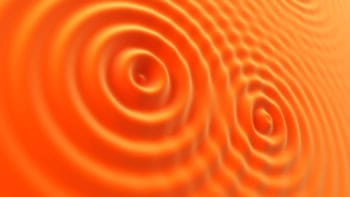
The cosmic microwave background (CMB) is a rich source of information about the early universe, and now physicists in Switzerland and Germany reckon it could also serve as a detector of high-frequency gravitational waves, which are ripples in space–time. Indeed, the researchers have used pre-existing radio observations of the CMB to calculate new upper limits on the size of high-frequency primordial gravitational waves.
The best developed technique for detecting gravitational waves, and the one used to discover them in 2015, relies on interferometry. In LIGO and other observatories, laser beams are deflected between mirrors at the ends of long (several kilometres) evacuated pipes and then interfere with one another. When a gravitational wave travels through the Earth it causes tiny changes in the distance between the mirrors, which is observed as changes in how the light interferes.
The size of interferometers like LIGO makes them most sensitive to gravitational waves within a certain frequency band – from about 10 Hz to 10 kHz – meaning that much of the gravitational-wave spectrum remains unexplored. While the planned space-based LISA observatory will target lower frequencies in the millihertz range to detect waves from supermassive black holes, observations at megahertz, gigahertz or even higher frequencies could provide a window on exotic phenomena in the very young, hot universe. Detecting these high frequencies could also provide new insights into the fundamental constituents of nature, by allowing tests of the Standard Model of particle physics at energies beyond the most powerful particle colliders.
The Gertsenshtein effect
To observe these higher frequencies, physicists have investigated a range of alternative approaches. This latest effort relies on the Gertsenshtein effect, which involves gravitational waves converting into electromagnetic waves (or vice versa) in the presence of a magnetic field.
While other researchers have looked for this effect in the results of pre-existing terrestrial experiments, Valerie Domcke at the CERN laboratory in Geneva and Camilo Garcia Cely at DESY in Hamburg have come up with a way for detecting the effect at cosmic scales. The idea is to scrutinize the spectrum of the all-pervasive CMB, which was produced about 400,000 years after the Big Bang when electrons combined with protons to form neutral hydrogen. Whereas today’s leading cosmological model tells us that this spectrum should be that of a black body, significant cosmic conversion of gravitational to electromagnetic radiation at megahertz to gigahertz frequencies would instead raise the intensity of the CMB’s low frequency “tail”.
The researchers specifically looked for distortions in the CMB spectrum generated before the first stars formed and hydrogen started reionizing, some 150 million years or so after the universe came into being. During these “dark ages” there were few free electrons to scatter photons, so the probability of oscillations occurring between gravitational and electromagnetic waves was higher than it would otherwise have been.
EDGES and ARCADE2
To set new limits on the size of gravitational waves at high frequencies, Domcke and Garcia Cely analysed data from two radio telescopes designed to peer far back in time. One, EDGES, consists of two dipole antennas and a dish located in the desert of Western Australia. The other, ARCADE2, was a balloon experiment flown over Texas.
The researchers found they could indeed use the data to set new limits, although they did have to make an assumption about the strength of cosmic magnetic fields. With the fields set low, their results were less stringent than those from putative terrestrial oscillations – the maximum amplitudes at 78 MHz (EDGES) and 3-30 GHz (ARCADE2) coming in at one part in 1012 and 1014 respectively. But with the fields set high, those limits dropped to one part in 1021 and 1024 respectively, the latter being seven orders of magnitude lower than limits imposed by the most sensitive laboratory experiment.

Microwave anomalies strengthen the case for loop quantum cosmology, say physicists
Domcke and Garcia Cely argue that their new approach to gravitational-wave detection could improve substantially as radio telescopes become more sensitive – particularly as scientists develop new facilities to measure the 21 cm line in neutral hydrogen, which is central to studies of reionization. More sensitive telescopes would set tighter limits on primordial gravitational waves or could even reveal their existence. They say that this radiation could in principle be produced by sources such as merging light black holes or from clouds of dark matter around spinning black holes.
They add that excess photons with frequencies below 10 GHz have been observed by both EDGES and ARCADE2. However, they point out that this excess would imply that gravitational waves have far more energy than that inferred from other cosmological observations. As a result, they say that astrophysical sources, “are a more likely explanation for the excess radiation observed”.
A paper describing the work has been accepted for publication in Physical Review Letters.



